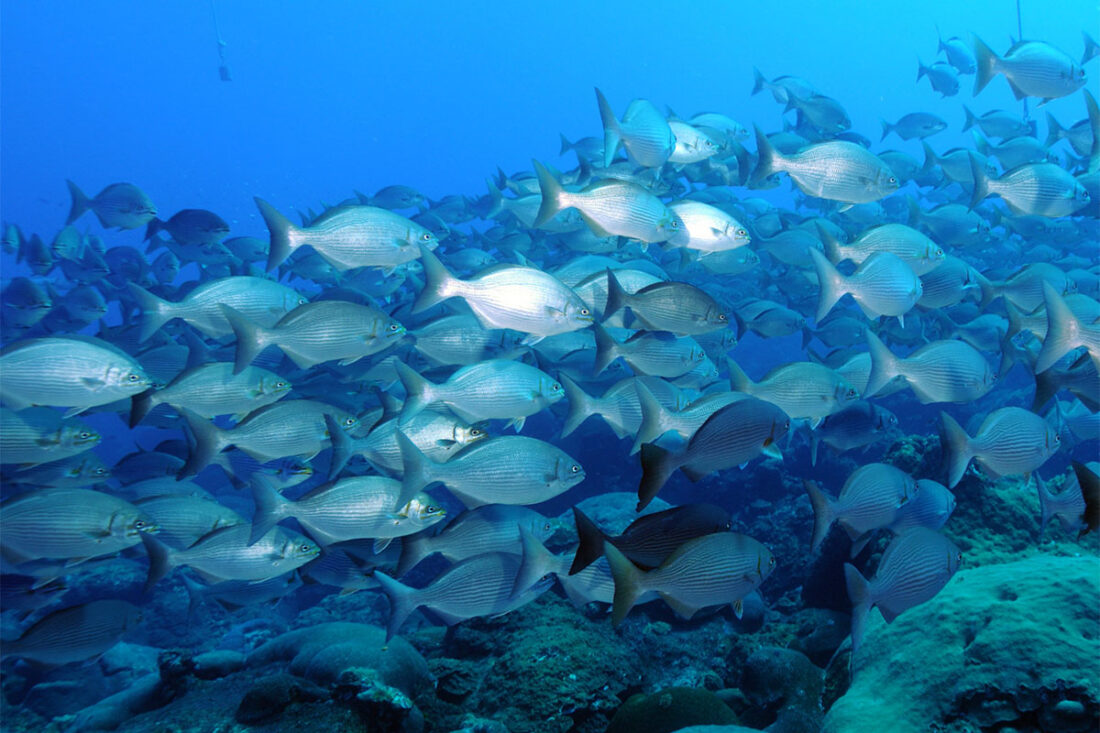Saltwater habitats, including oceans, seas, bays and inlets, are home to over half of the world’s fish species. Saltwater fish can live in the deepest depths of the ocean or just inches under the water’s surface. Knowing where a particular species of saltwater fish can be found is key to having a successful fishing experience.
While there are many saltwater habitats, there are three basic types of marine habitats or environments where most saltwater fish live.
- Pelagic fish: These species include saltwater fish that live in areas that are not near the bottom the ocean or the shore. Pelagic fish are typically categorized as coastal or oceanic fish, depending on the depth of water they inhabit. Coastal pelagic fish are usually found at depths to 650 feet. Oceanic pelagic fish, such as tuna, mackerel, wahoo, swordfish, and even some sharks, generally inhabit waters below the continental shelf.
- Demersal fish: Some referred to as ground fish, demersal fish live and feed on or near the sea floor. Flounder, cod, halibut, haddock and flatfish are examples of popular demersal sport fish.
- Reef fish: As their name suggests, reef fish species live in or close to coral reefs. Red snappers, mangrove snappers, gag grouper and black sea bass are examples of common saltwater reef fish.
Now that you’re familiar with the three basic saltwater fish habitats, you can visit our saltwater game fish guide to identify the sub-habitats for the specific saltwater species you want to target.
Below you’ll find a directory of the different sub-habitats to look for when saltwater fishing.
- Channel Entrances
- Channels and Holes
- Coastal Waters
- Colliding Waves
- Convergence Zones
- Deep Shore Water
- Hills and Humps
- Jetties and Breakwaters
- Kelp Forests and Beds
- Oyster Bars and Grass Beds
- Piers, Docks and Pilings
- Points and Break Lines
- Potholes
- Rip Tides
- Rocky Sea Floor
- Saltwater Inlets
- Saltwater and Tides
- Saltwater Weed Beds
- Schools
- Shallows and Shoals
- Shore Points
- Shoreline Shallows
- Surf and Shore
- The Open Ocean
- Tidal Flats
- Troughs
Channel Entrances
Wherever water is being pushed into a smaller opening, you’ll find faster currents that will dig into the bottom, creating a dip. Fish like to hang out around these places because the water is deeper, and the food supply is more condensed.
Channels and Holes
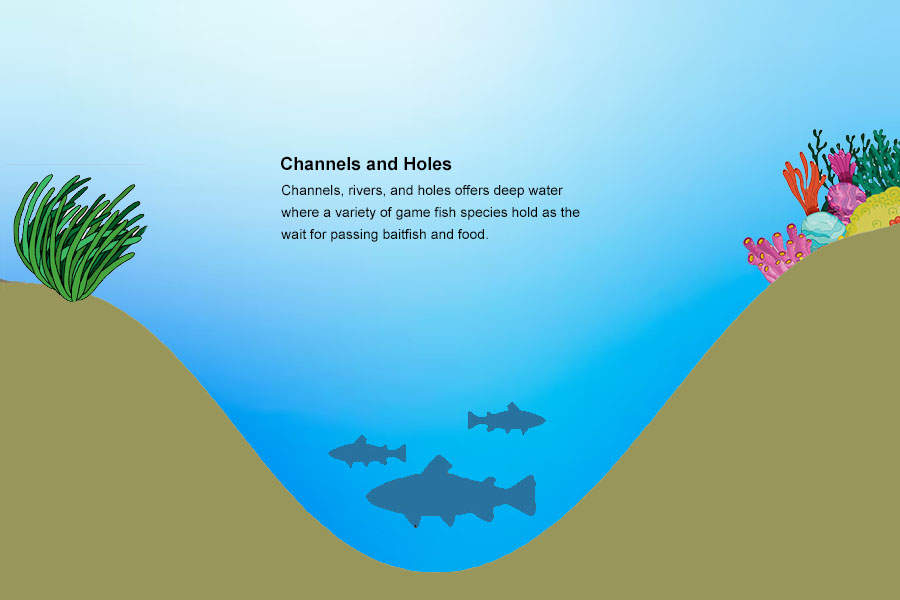
A dip at the bottom of a bay, such as a hole or channel, is another great place to find fish. Because they are great hiding places, fish often use these holes or channels to get away from larger fish that are looking to eat them.
Fish like to hang out in these holes because the deeper water:
- Is often colder, giving the fish a place to go when the water temperature gets too high.
- Is cleaner and has a higher concentration of salt.
- Is a great place for larger fish to find smaller fish to eat.
TIP: If you want to catch fish in these holes, try drifting your bait using a two-hook bottom rig. As the hole gets deeper, let out more line so your bait stays on the bottom. You can also try trolling through the hole by dropping several lines in different areas. This will give you a better chance of success since the fish may be moving in different directions, depending on the location of the food and direction of the current.
Coastal Waters
In areas near the coast, you may find many different structures, like sections of debris, coral or exposed rock. These areas are good hiding spots for smaller fish; therefore, they also attract predatory fish. Little fish like to feed on the ocean bottom near these structures, then dart back into them for shelter. Bigger fish also like to hide in these areas to ambush the smaller fish. Coastal waters are great for deep-sea fishing because they’re easy to get to and they contain a large variety of fish. Many species of fish use the coastline to travel for migration each season. Experienced fishermen know how to check currents, water temperatures, seasons, tides and winds to determine the best fish to go after.
Colliding Waves
Currents will collide underwater near man-made or natural structures, such as inlets or points. Food sources collect in these areas and in the surrounding water column, which means you can find small fish and predatory fish here. To identify these areas, don’t look for breaking waves. Instead, keep your eye out for something calmer.
Convergence Zones
Bays and estuaries contain both salt water and fresh water, which makes for a unique fishing experience. Also known as convergence zones, these areas provide good fishing because the change in the salt content of the water attracts saltwater fish looking for a place to eat or breed. To us, the area where this water converges looks like a slight color change in the water, but to a fish, it can act like a brick wall. Since the converging water can be different temperatures, have different currents or even have different levels of salinity, it can act as a feeding station for different types fish.
Always check both sides of the break when you’re fishing in one of these convergence zones in a bay. You can do this by trolling, casting out towards the break, or simply drifting your baits.
TIP: Whether you’re searching for a good fishing spot in the backwaters or the deep ocean, you can use similar methods to find fish. Learn to look for structures, monitor weather conditions and check water temperature. These things, as well as choosing the right bait, will help you find fish. And if you’re bay fishing and the wind gets too strong, you can always head inland and try your luck there.
Deep Shore Water
Pockets of deeper water can form when a current runs along a shore. You can usually spot these areas by looking for a color change in the water – the deeper water will be darker. Predator fish like to hide in these spots waiting for prey to swim by. You might be surprised by the size of the fish you catch here.
Hills and Humps
Hills and humps located within bays are good places to fish. These large variations in depth and bottom topography usually affect the current and can offer ample hiding places for small fish.
Here are a few tips for fishing around hills and humps:
- The best way to find hills or humps is to consult a bathymetric chart before you head out onto the water. Once you get close to the hump or hill, use your GPS and fishfinder to locate the structure, then get your boat right on top of it.
- Most of the time, you’ll need to drag your baits along the bottom or try your live baits at different depths while your boat drifts along. Trolling also works well around hills and humps – both with live baits and lures. You can also choose to anchor your boat and simply drop your baits near the bottom of the structure.
- Once you have a fish on your line, you’ll know there are probably others swimming around. It will help you if you mark it on your GPS so you can drift over the same spot again and see if you can get another fish to bite.
Jetties and Breakwaters
The best jetties to fish near are those that spread out into the deeper water and affect the current. The rocks normally found beneath jetties are home to baitfish and crustaceans that larger fish like to eat. This makes them good places for surf fishing. Water also tends to crash up against these structures, causing holes to form where the water pulls the sand out as it recedes. These holes are great places for fish to hide from other fish and offer shelter in the form of calmer water. These are also great spots for larger fish to hide out so they can ambush smaller fish. Another great thing about jetties and breakwaters is that they allow you to fish in deeper waters.
- When fishing in an inlet, don’t let your bait drift too far away from the rocks.
- When jetty fishing, don’t get stuck on one type of bait.
- If you’re using lures for jetty fishing, opt for jigs.
- When fishing in an inlet, try several different spots.
- Keep fishing on the jetty even after the sun goes down.
If you like to fish from the shore and want to have access to many species of fish, jetties are a great option. With jetties, you get a mix of current, structure and food sources, which makes them attractive to predator fish.
Kelp Forests and Beds
Kelp forests and beds are found throughout the world’s temperate and polar coastal oceans. In the United States they are most common along the Pacific coastline spanning from Oregon to California. Small concentrations of kelp are referred to as kelp beds. Larger concentrations are known as kelp forests. Kelp beds and forests provide a thriving ecosystem for marine life and a productive habitat for a variety of large game fish. The best way to catch fish living within kelp is the free lining live or dead bait from an anchored or drifting boat. If free lining your bait doesn’t produce a bite, then add weight to your rig until the fish start biting.
Some anglers recommend using brown and red swimbaits for best results when fishing in the kelp. You’ll also want to use braid line as it will cut through the kelp with ease. Monofilament can snag and break on the sharp edges of shell attched to kelp.
Oyster Bars and Grass Beds
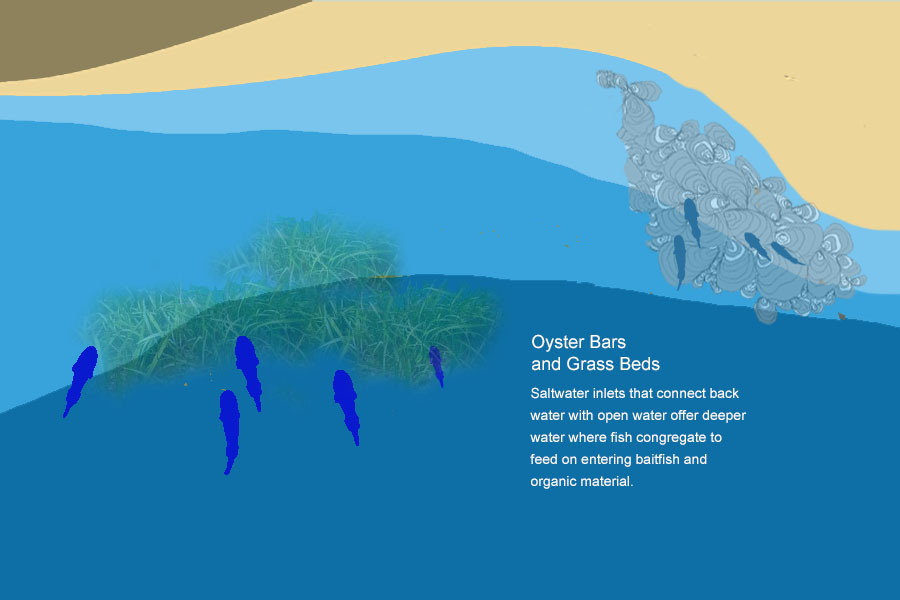
Oyster bars and grass beds are a part of the natural food chain. These backwater reefs can be difficult to fish, however, because they provide a lot of opportunities to snag your line. Therefore, when you’re fishing in these areas, you’ll want to use a popping cork, jig or topwater lure to suspend your bait over the bottom. Fish like to swim around the outside edges of these oyster bars and grass beds looking for their next meal, so this is exactly where you want to aim your lure.
TIP: To avoid scaring the fish, you’ll want to use a boat with a push pole or trolling motor.
Piers, Docks and Pilings
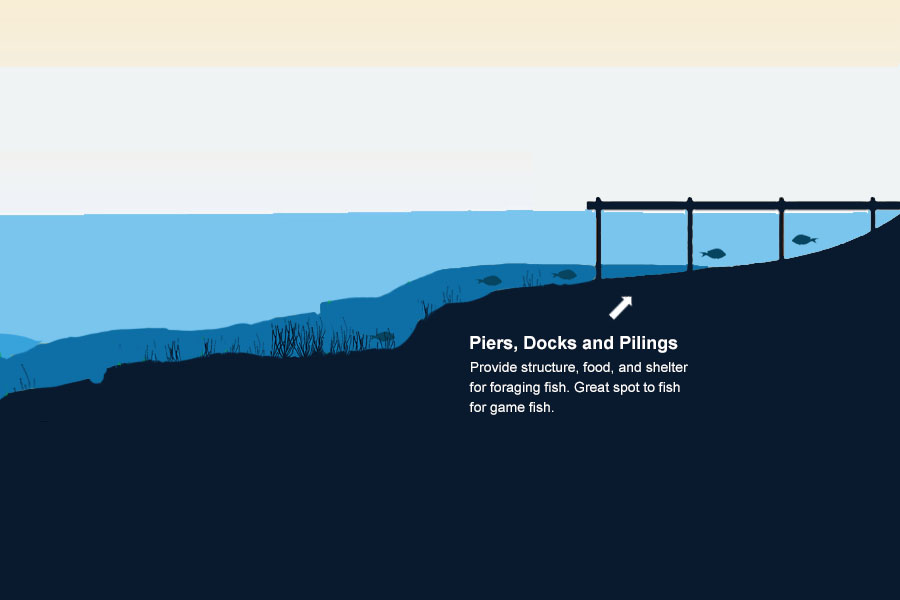
Piers, docks and pilings create an environment where fish can go to seek food and shelter. They’re often covered with weeds and barnacles and also provide shade from the sun. This is the ideal place for many fish to rest and hang out.
Points and Break Lines
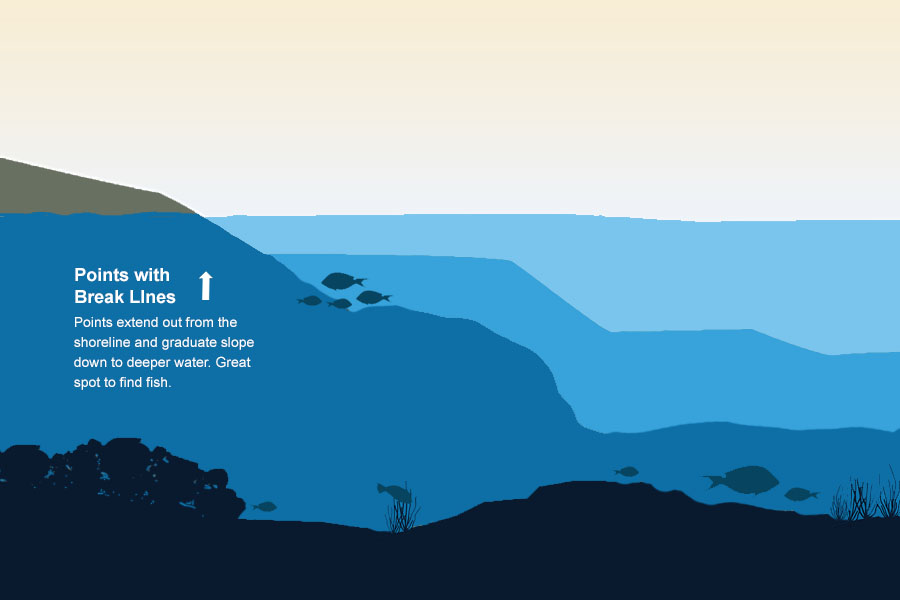
Since points tend to create a gradual sloping line from the shoreline into deeper water, they’re good places to fish. Here’s what makes them so appealing:
- The gradual slope of the point makes a break line.
- The break line attracts deep-water fish to the shallower water to get food.
TIP: For the best chances of success, fish at the end of the point or on the part that curves back to the shore. Just make sure the point you choose doesn’t have a quick drop-off or stop in shallow water – these aren’t good options for fishing.
The edge of a drop-off running perpendicular to the shore is called a breakline. Many people troll breaklines, following an S-pattern near the shoreline and switching between deep and shallow water. You may even have done this without being aware you were fishing a breakline. Some people will refer to the breaklines as primary and secondary. The primary breakline is the first major change in depth when moving from shore to the ocean. The secondary breakline is the next major change in depth that follows the primary breakline.
You can think of breaks as underwater walls or stairs – either way they are good places to fish. Note that you won’t always find fish along the whole breakline. The ideal spots to find fish along a breakline are those that include other features, like a bend or cut, or places to hide, like weeds.
Potholes
You’ll find potholes in grass flats where there are bald patches with a muddy or sandy bottom. These potholes can be different shapes and sizes – from a few feet to several yards wide. They also make great places to fish because saltwater game fish like sea trout and redfin use them as hiding places to stalk their prey. These predatory fish like to sit at the edge of the pothole and wait for crustaceans or baitfish to wander by, then snatch them up. So, if you’re fishing these areas looking for redfish, rig a popping cork with a pinfish or live fish, then cast it into one of these potholes. And if you fish one of these areas during a running tide, you’ll have even better luck.
If you get to a point where you feel comfortable with flats and backwater fishing and understand which tackle and bait to use, you may want to add some additional challenges. Try your hand at something new by scheduling a fishing trip offshore or in the open ocean.
Rip Tides
Water doesn’t like to be confined. If obstacles, such as points, try to interrupt its flow, it will try to find the quickest way out. As it works to escape, it forms faster-moving pockets of water. Since this faster water tends to carry sand or mud out with it, you’ll often be able to identify it by the change in color.
These areas with faster water flow create rip tides, which make for an ideal fishing location. The swiftly moving water carries baitfish with it and inshore predators like to wait in these locations for the fish to float by. You can find all kinds of larger fish near rip tides, including bluefish, bonito, striped bass, fluke and false albacore.
Rocky Sea Floor
There aren’t many structures out in the open ocean. This is why you’ll often find game fish hanging out near underwater areas that offer shelter. The rocky bottom, though not as appealing to fish as a reef, still provides plankton and baitfish with some protection. They also offer predator fish opportunities to ambush their prey, making them great places to fish. If you plan to fish in open waters, jigging and dropping are the best methods to use.
Saltwater Inlets
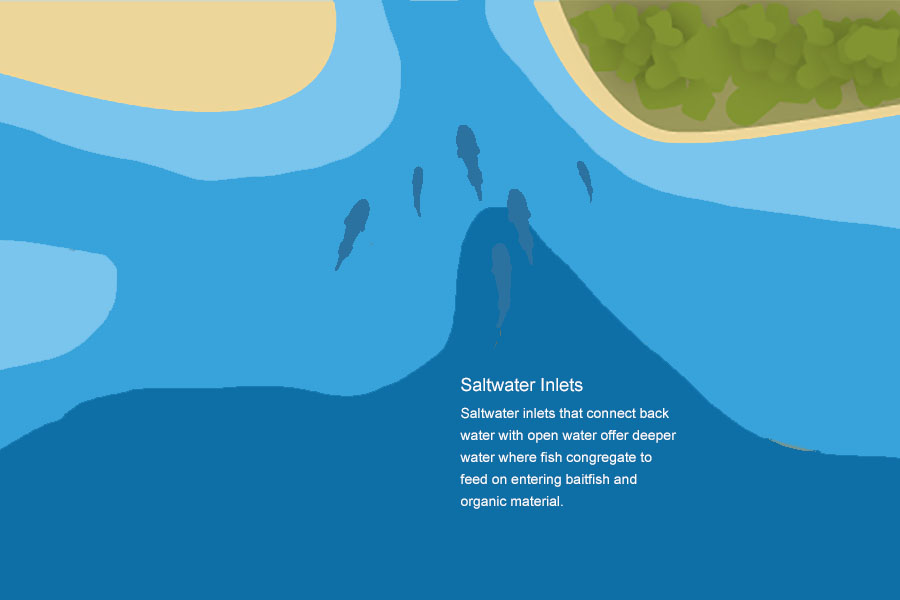
Saltwater inlets are good places to fish because they contain moving currents. You can find saltwater inlets by looking for shallow sandbars or rocks that border deep channels. To find fish, you’ll need to figure out where the water is deepest. Then, look to see if there are any nearby structures. Baitfish will group together in the deeper water and predatory fish will hide in the nearby structures waiting to strike.
Here are two tactics to use when fishing in saltwater inlets:
- Drifting: Let your boat float gently through the deeper water along and over the shoals as you bounce a jig or bottom rig in the water.
- Anchoring: Throw out your boat’s anchor and cast your metal spoons, live baits or soft plastic lures into the current. Then let the current gently push them past the fish.
Saltwater and Tides
How and when fish feed will depend on the raising and lowering of the tides. Tides generally change twice per day and the timing of those changes differs from day to day and region to region.
A great, shallow fishing spot during the high tide may become a bare mud bank during low tide. Likewise, low tide may provide a great slough to fish in, but once high tide hits, that spot may no longer hold fish.
The best time to fish is during rising or falling tides, also called running tides. These cause bait to move, which creates ideal feeding situations. It’s important to be aware of the changing tides when you go fishing – especially in brackish water. This mix of salt and fresh water, which is attractive to both fresh and saltwater fish, is often found in rivers and tidal creeks on the coasts. Due to its proximity to the ocean, brackish water is highly affected by the changing tides.
You’ll do best by fishing during the rising or falling tide. You want to avoid times when the tide is at a dead high or dead low. Also referred to as “slack tides,” these times offer little or no tidal current.
Saltwater Weed Beds
Once you get really good at fishing, you’ll start to notice color changes in the ocean waters. You’ll become adept at spotting weeds and the fish that hang out around them. Since small fish like to feed on the weeds, you’ll also find larger fish near weeds trying to ambush the smaller fish. Your best chances of success will be when fishing along the edges of these weeds.
Schools
Schools of baitfish can swim so tightly together that the water they are swimming in actually changes color. If you watch closely, you can spot these moving patches, which make for great fishing. Simply cast your lure or bait ahead of the moving mass and let it float right into the school.
Shallows and Shoals
Shallow shoals are similar to hills, channels and holes in that they make great bay fishing habitats. Look for a change in the bottom structure when you’re fishing in shallow water. This is where you’ll find saltwater fish. The best time to fish these areas is at night when the fish move into these areas without fear of being swept up by a seagull or fish hawk. The best techniques to use in the shoals include trolling, drifting and anchoring. The exact method you use will depend on the fishing situation.
TIP: Be very careful when fishing in shallow water. The changing tides can cause your boat to run aground, get hit by a wave or damage the habitat.
Shore Points
A point is a naturally occurring mound of sand that sticks out of the water from the shore to the ocean, creating a current. Because the current moves faster than the rest of the water, it erodes the sandy bottom, creating places where deep holes border shallow water. These holes are good places to find fish. When the tide is low, try wading out onto the point so you can cast past the breaking waves. As the tide comes in, you can try fishing in the bars and holes that become exposed. Just make sure you’re careful when fishing out on points because the fast-moving water around them can quickly push you into deeper water.
TIP: To be safe when fishing in the surf, make sure you understand the tidal conditions and bring a friend along, whenever possible.
Shoreline Shallows
Fish are attracted to the shoreline because the water next to the shore holds many opportunities for food and good places to hide. Baitfish will come to these areas to feed on the plants and bigger fish, like sunfish, perch, crappies and bluegill will come to eat the baitfish. There are also times of the day – early morning and late at night – when game fish, such as pike or muskie, come to the shoreline to snack on other fish that are there. So, if you’re after game fish, these are the best times to fish these areas.
Surf and Shore
You have many choices for fishing along a coast or shore. You can fish in a boat, from a jetty or breakwater or even just by standing on the shore. Some people even like to wade into the surf and cast out past the breaking waves to catch the fish lurking out in the ocean.
Fishing along a coast or shore is not always easy because there are limited structures to attract fish. To have success in these areas, learn to look for color changes in the water, read the waves, understand migration patterns and check the water temperatures.
The Open Ocean
You should only try fishing in the open ocean once you’ve had plenty of experience with other types of fishing. In the open ocean, you’re generally targeting larger, stronger fish that require specialized equipment and boats. Your best bet if you don’t have all of this equipment yourself is to hire a fishing charter.
Make sure you ask a lot of questions when calling around to decide which fishing charter to hire. You’ll want to find out what types of fish you’ll target, how long the trip will be, how many people the boat can hold, and if you’ll be the only people on the boat.
Additionally, if you plan to keep the fish you catch so you can eat them for dinner, make sure you check the boat’s policy on keeping those fish. Not all charters allow you to do this. In some areas, charter crews may have a policy that says they get to take the fish that you catch to local auctions. You also don’t always have to keep a fish that you want mounted. Just make sure you take several pictures of the fish when you catch it so the taxidermist can make an exact replica.
You can open-ocean fish pretty much anywhere in the country, but depending on the location, you may need to go further from shore to find the best fishing spots. On the east coast, you’ll often have to go out further to find the best fishing, with Southern Florida being an exception. However, on the West coast, where there are many more steep drop-offs, you can usually fish closer to shore.
Out in the open ocean, you’ll find pelagic fish, which include wahoo, dolphin, tuna, billfish and some sharks.
Tidal Flats
A tidal flat is a very shallow area of water with sandy, muddy bottoms. These flats are sometimes exposed by the low tide and can be a few inches to several feet deep. Since these areas offer shelter from the heavy waves, they tend to be good places to find fish. Tidal areas form when tidal channels transport mud and sand and drop it off in a location.
Troughs
You’ll want to pay special attention to the areas where the waves break offshore. The breaking water often creates a type of ditch that runs parallel to the shore, also known as a trough. These areas create fast-moving currents that attract crustaceans and baitfish. If you see birds circling over a certain spot, you’ll want to look near the water’s surface to see if you can see a school of fish. Use your finder rig in these spots to see if you can locate any pompano, flounder, sea trout or bluefish.


